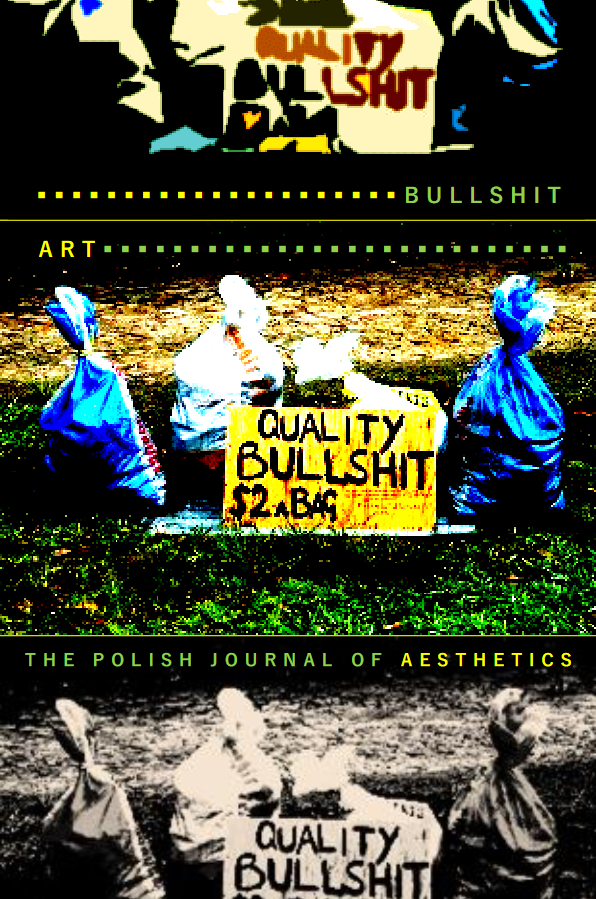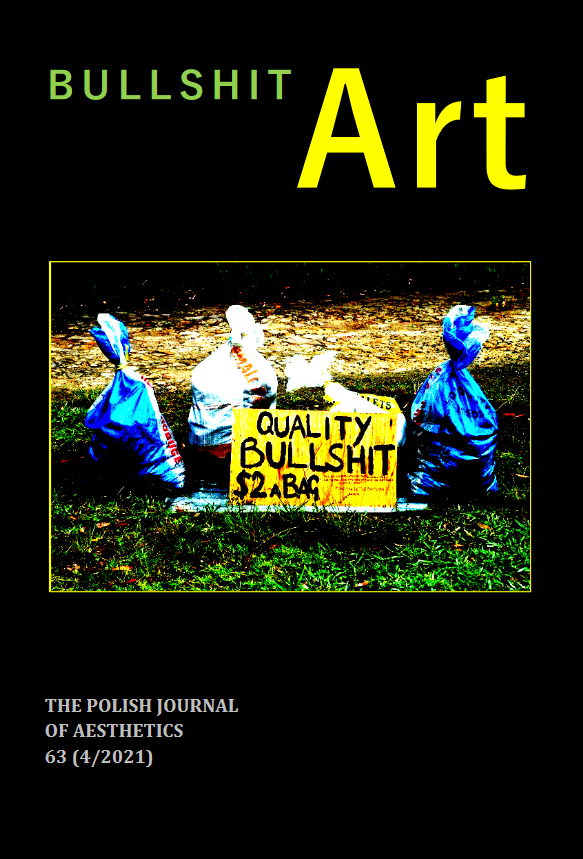Numer 63 (4/2021)
Bullshit Art|
Spis treści
Strony
Pobierz
|
|||||
|
|
|||||
|
|
|||||
|
Słowa kluczowe Artspeak |art theory |Evocative Bullshit |International Art EnglishStreszczenie Pseudo-profound language is a stylistic means in many different contexts, like advertising, politics, economics, or even science. Contemporary visual art is notoriously known for its variant: artspeak. We develop a syntactical analysis and show how artspeak is constructed. We point out that it is “evocative” bullshit in that it aims at contextualizing art with traditional art myths (i.e., artists are, among other adjectives, autonomous, critical, or free). Furthermore, we argue that artspeak should be regarded as a particular type of bullshit as it features a unique relation to truth. |
|||||
|
|
|||||
|
Słowa kluczowe Abstract Expressionism |CIA |Formal Pragmatics |critical theory |BullshitStreszczenie Beginning with a definition of “bullshit” in academic vernacular where standards of verification are broken down, general examples are provided in aesthetics and politics. A highly successful example of bullshit in the art industry is explored, that of abstract expressionism in the US, noting its support from the CIA. Reviewing the context and style illustrates that abstract expressionism is an anti-aesthetic produced by parasites, an easy target for such bullshit manipulation. INFORMACJE O AUTORZE
University of Melbourne, Australia
|
|||||
|
Lucas Scripter
Kitsch and the Social Pretense Theory of Bullshit Art
DOI: 10.19205/63.21.3
47 – 67
|
|||||
|
Słowa kluczowe Bullshit |kitsch |Nonsense |Social Pretense |artStreszczenie This essay argues that bullshit art is a meaningful concept that differs from bullshitting about art, although the two may occur in tandem. I defend what I call the social pretense theory of bullshit art. On this view, calling a work of art ‘bullshit’ highlights a discrepancy between the prestige accorded a work of art and its nonsense character. This category of aesthetic criticism plays a unique role that cannot be identified with kitsch but bears only a contingent connection to it. INFORMACJE O AUTORZE
University of Hong Kong, Chiny
|
|||||
|
|
|||||
|
Słowa kluczowe kitsch |Non-fungible Tokens |Beeple |Injective Protocol |authenticity |BullshitStreszczenie The NFT art world is a mixture of late capitalism and populist aesthetics in which any idea of an “adequate artistic expression” has become increasingly difficult. Beeple’s digital artwork “Everydays: The First 5,000 Days” sold for $69.3. Twobadour, one of the two buyers of the work, thinks that work “is going to be a billion-dollar piece someday.” Until recently, “art” as a vague institution could still provide some landmarks about the ‘how’ of art and the discourse attached to it. Galleries and museums played a role in promotion, which sparked debates, both public and elitist. Curators, who are generally excluded from the financial craze, functioned as gatekeepers. Once NFTs are introduced into a highly speculative art market, any notion of aesthetic “truth” becomes dysfunctional. Authenticity emerges from the Enlightenment tradition for which being authentic meant to be free and autonomous. In the twenty-first century, authenticity needed to be installed in nonmateriality, and NFTs are the latest result of this process. Dematerialization means despatialization. The digitized version of a work is authentic, but authentic has here a meaning different from what it was before. The shift goes hand in hand with the reissuing of authenticity as a highly abstract category that is common in the twenty-first century. INFORMACJE O AUTORZE
Gulf University for Science and Technology, Kuwejt
|
|||||
|
Eva M. Dadlez
What Bullshit, Kitsch, and Moral Grandstanding Have in Common
DOI: 10.19205/63.21.5
85 – 96
|
|||||
|
Słowa kluczowe Bullshit |kitsch |Grandstanding |Virtue SignallingStreszczenie Moral grandstanding contravenes the aims of ethics in the same way that kitch contravenes the aims of art and bullshit violates the aims of justifiable assertion. Using the work of Harry Frankfurt on bullshit, Tomas Kulka on kitsch, and Justin Tosi and Brandon Warke on grandstanding, this paper will explore the parallels among these transgressions. INFORMACJE O AUTORZE
University of Central Oklahoma, USA
|
|||||
|
|
|||||
|
Słowa kluczowe Plato |Nonsense |Mystery |Stiegler |Proletarianization |play |IndividuationStreszczenie This paper discusses the problem of knowledge’s indeterminacy with an account of the sophists and bullshit artists. I analyze bullshit as a default, after which I look at the sophists and bullshit artists to subsequently discuss caring about mystery, art, and bullshit (nonsense and madness). The analysis mostly looks at Plato’s account of sophistry while supplementing it with others. I use Bernard Stiegler’s phenomenology to explore the different modes and applications of the term bullshit (nonsense, madness, etc.), understood existentially as a default of being, rather than propositional truth, to show the specific relation between bullshit, techne qua abstraction, and the living experience of indemonstrability, i.e., mystery. The specific relation between aletheia and bullshit artists and sophists will turn out to be their complex ability to appeal to emotion abstractly through concealment and disclosure. Bullshit and art inherently share an ontological unprovability. They can transform the mysterious into mystification through formulae, a lack of care for meaningful critique. We can be initiated into a practice that disregards usefulness, such as art, via mystagogy. INFORMACJE O AUTORZE
Uniwersytet Jagielloński w Krakowie
|
|||||
|
Aaron Weddle
Performative Communication & Bullshit as Compelling Aesthetic
DOI: 10.19205/63.21.7
123 – 139
|
|||||
|
Słowa kluczowe Aesthetics |Bullshit |trust |performance |communicationStreszczenie In this paper, I use the work of Harry Frankfurt and Jason Stanley to explain why bullshit works so effectively, especially in politics. I use Stanley's conceptions of knowledge-how to posit a theory of communication, as well as the roles of communication and how communication is received. I elaborate on bullshit as concept, and how it is communicated in a way to garner the trust of the listener through convincing performance and aesthetic. INFORMACJE O AUTORZE
State University of New York at Binghamton, USA
|
|||||
|
Sergio J. Aguilar Alcalá
I Believe to Know: Scientific (Fake) Documentary and the Impasses of Scientific Knowledge
DOI: 10.19205/63.21.8
141 – 156
|
|||||
|
Słowa kluczowe psychoanalysis |science |documentary |knowledge |BeliefStreszczenie This text discusses three documentary films (a fake documentary, an episode of a scientific documentary series and a documentary on flat-Earthers) to discuss the limits of knowledge and belief for scientific discourse, and how psychoanalysis enters this debate by insisting in the presence of a subject (a subject of the signifier, not the psychological subjectivity). This, in turn, reflects on a political task for documentary cinema: to assume a subjective position, insofar as they are not films that are true or manipulative, but films about the structural place of Truth, and as such, they reflect on the gap between knowledge and belief. |
|||||
|
Sarp Tanrıdağ
A Constructive and Speculative Case of Bullshit Art: the Etchings of G.B. Piranesi
DOI: 10.19205/63.21.9
157 – 171
|
|||||
|
Słowa kluczowe Bullshit Art |fiction |Giovanni Battista Piranesi |objectivity |rhetoricStreszczenie This article analyzes the constructive and speculative forms of bullshitting in the art field through the etchings of G. B. Piranesi. In reviewing the historical context and the allegorical and technical aspects of his etchings compared to H. Frankfurt’s definition of bullshit, the study contends these artworks’ propositional and unique rhetorical languages. Consequently, it explores a potential form of bullshit art that is manipulative and fictional but also constructively critical. INFORMACJE O AUTORZE
Orta Doğu Teknik Üniversitesi (ODTÜ), Turcja
|
|||||
|
|
|||||
|
Słowa kluczowe Bullshit Art |Bad Art |Transgressive Art |High Culture vs. Low Culture |Art System |Tommaso Labranca |Anna Choutova |VraghinarodaStreszczenie This article explores the possibilities offered by Bad Art within the art system, which at times still appears as an elitist world that few understand and have access to. Starting from the article "Exhibit Bad Art" (Gompertz, 2012) we will interview Anna Choutova, head of the curatorial project "Bad Art", and link the thoughts of art critics and scholars who highlight the potential of Bad Art as a popular, ironic and accessible art form, showcased by institutions such as The Museum of Bad Art. INFORMACJE O AUTORZE
Università di Bologna, Włochy
|
|||||
|
Katarína Ihringová
Trompe lʼoeil and Bullshit—The Problem of the Truth of Realistic Depictions
DOI: 10.19205/63.21.11
191 – 205
|
|||||
|
Słowa kluczowe Bullshit |Trompe l’oeil |Slovak Visual Arts |Realistic Art |The Problem of the TruthStreszczenie The term bullshit, coined by the American philosopher H. Frankfurt, reflects communication within contemporary society as lies that do not stem from the truth and are often preferred over profound truths. The history of visual arts, specifically realistic art, employs trompe l’oeil—a visual depiction that pretends to be reality, even though it is not. It may give the impression of a real object when perceived, although it is a mere visual depiction. We will discuss trompe l’oeil from the perspective of the concept of bullshit through an analysis and interpretation of works of trompe l’oeil in contemporary Slovak art. We will address their problematic link with the truth by comparing both concepts using their similarities and differences. This text was created at the Department of History and Theory of Art FFTU in Trnava, as part of the solution of the grant task KEGA 025TTU-4/2021Empathy and art: the viewerʼs empathic and emotional response to visual art. INFORMACJE O AUTORZE
Trnavská univerzita v Trnave (Uniwersytet Trnawski), Słowacja
|
|||||
|
|
|||||


